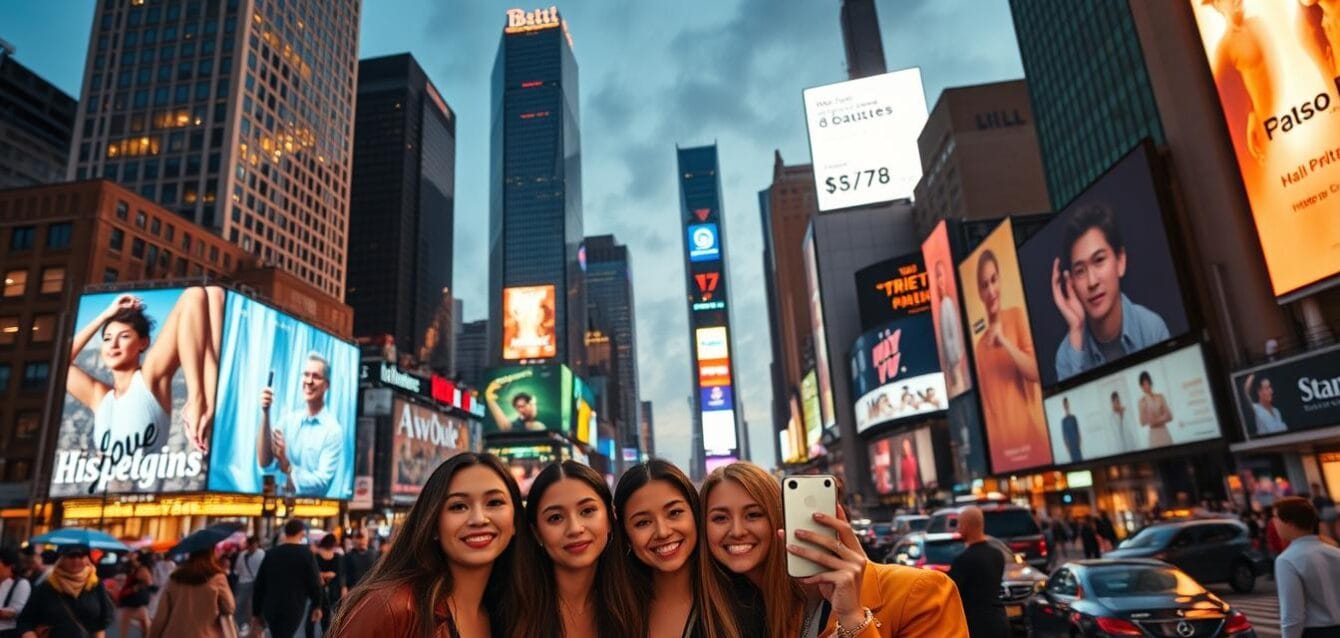Fact: in 2024, average programs returned about $5.20–$5.78 in revenue for every $1 spent — and top performers reached $20+ per $1.
We open with that because high-ticket brands must stop optimizing for vanity and start engineering measurable growth. We believe programs should drive provable revenue, higher CLTV, and repeatable scale.
In this guide we outline a premium framework: precise goals, tight unit economics, audience-first creator selection, and content built to convert. Attribution tools like UTMs, GA4, HubSpot, Triple Whale, and Hyros are the unlock that ties touchpoints to sales and retention.
Our promise: practical playbooks—affiliate links, whitelisting, seasonality pushes—and process fixes that compress payback and raise margins as budgets grow. We position ourselves as partners who engineer channels into controllable growth levers with predictable marketing ROI.
Key Takeaways
- Average returns sit near $5.20–$5.78 per $1; elite programs can hit $20+.
- Measure beyond likes: track conversions, CAC, CLTV, and ROAS.
- Attribution and integrations are essential to tie campaigns to revenue.
- Standardized scopes and local creators cut costs and increase margin.
- We provide actionable systems to maximize influencer marketing and scale reliably.
The 2025 reality check: why your influencer campaigns aren’t hitting ROI yet
Most teams still judge success by reach, not revenue, and that gap sinks premium campaigns.
We see three root causes. First, teams optimize for impressions and likes while the P&L needs CAC discipline and CLTV lift. Second, nearly 30% of brands don’t track returns, so insights never translate to better buys. Third, high-ticket offers suffer longer consideration windows and multi-touch paths that simple metrics miss.
Reframing success means coupling engagement with attribution: UTM-tagged links, unique codes, and CRM integration that map social touchpoints to pipeline and sales. When creators match audience intent and cost structures are tuned, returns move from the $5.20–$5.78 average toward elite programs that hit $20+ per $1 spent.
Quick benchmark and fixes
- Stop optimizing vanity; measure CAC payback and AOV.
- Instrument every post with tracking and CRM touchpoints.
- Repurpose creator assets for paid ads and landing pages to compound value.
| Metric | Average | Elite |
|---|---|---|
| Return per $1 | $5.20–$5.78 | $20+ |
| Measurement gap | ~30% not tracking | Full UTM + CRM capture |
| Primary fix | Track engagement + sales | Audience-fit creators + unit economics |
Influencer Marketing ROI defined and measured the right way
To score real business impact, we align creative activity to measurable financial outcomes.
Start with the math: calculate roi using ((Returns − Investment) / Investment) × 100. Then expand that number to include brand lift and asset value so you capture the campaign’s full economic return.

The holistic framework
Count three pillars: direct sales, brand awareness (impressions, branded search, follower growth), and content value (what you save by repurposing creator assets).
Essential KPIs and tracking
- Reach efficiency: impressions, CPM.
- Resonance: CTR and hook rate.
- Demand & value: conversion rates, AOV, CLTV, customer acquisition cost.
- Unit economics: ROAS and documented campaign costs.
Hard-trace conversions with affiliate links and unique codes. Assume ~70% attribution capture and scale attributed sales upward to estimate true impact. Instrument every link with UTMs and use GA4, HubSpot, Triple Whale, or Hyros for cross-channel truth. Pre-campaign baselines and full cost logs make the final marketing roi defensible to finance.
| Measure | Why it matters | Target |
|---|---|---|
| Conversion rate | Shows demand and landing fit | Benchmark vs. paid funnel |
| CAC | Direct cost per new customer | Below CLTV payback threshold |
| Content value | Repurpose savings and ad asset lift | Equivalent production cost saved |
Set campaign goals that align to business outcomes, not just engagement
Begin with goals that map directly to profit and customer lifetime value, not vanity metrics. We frame every campaign around revenue, retention, and measurable lift before creative starts.
Map goals by funnel stage
We break objectives into stages: awareness, consideration, conversion, retention, advocacy. Each stage has clear, monetized KPIs.
- Awareness: reach, impressions, view-throughs tied to branded search lift.
- Consideration: CTR, saves, email signups mapped to pipeline value.
- Conversion: orders, AOV, and ROAS with unique codes and UTMs.
- Retention & Advocacy: repeat purchase rate, CLTV, and referrals.
Balance engagement with attribution
We pair engagement metrics with attributed sales and signups to see full impact. No KPI stands alone; every metric ladders to revenue efficiency.
Set targets using benchmarks
Targets come from industry benchmarks and your historical data by platform and creator tier. We lock scopes, plan tests, and assign decision thresholds so budgets scale when CAC and roi meet gates.
Control costs to grow margins: the unit economics of influencer marketing
Controlling spend starts with modeling every dollar and linking it to expected customer value.

We make unit economics explicit. Model all-in costs: fees, production, travel, shipping, tools, and internal time against projected revenue. This tells you which campaigns can scale.
Major cost drivers are creator fees, production, and logistics. Prioritize local creators to cut travel and simplify shipping. Specify deliverables and revision limits up front to remove scope creep.
Practical levers to protect margin
- Test first with gifting or affiliate structures to limit fixed spend.
- Standardize briefs, templates, and approval flows to reduce ops hours.
- Negotiate compensation using past performance and forecasted outcomes.
- Blend nano and micro creators for efficiency; deploy macro only when economics hold.
| Cost Line | Control Tactic | Key KPI |
|---|---|---|
| Creator fees | Performance structures & negotiation | Cost per conversion |
| Production & assets | Local shoots + reuse planning | Content value saved |
| Logistics & ops | Templates & workflows | Internal hours per campaign |
We monitor CPE, CAC, ROAS, and payback and run sensitivity scenarios. That discipline turns promising ideas into repeatable, profitable campaigns and improves influencer marketing roi across the brand portfolio.
Find the right influencers: audience fit beats follower count
Precision beats popularity: high-ticket campaigns win when audiences match product intent.
We hire for audience fit first. Validate demographics, interests, affinities, and geolocation before you consider follower size.
Audience-first vetting
Measure the people, not the profile. Use income proxies, category affinities, and platform behavior to confirm buyer intent. Discovery tools like Sprout Influencer Marketing speed this process.
Performance signals that matter
Examine engagement quality, sentiment in comments, past brand mentions, and content craftsmanship. Prioritize creators whose posts convert — not just entertain.
Test, then scale
- Run affiliate links and unique codes to track clicks, adds-to-cart, and orders.
- Accept the 80/20 reality: 5–10% of creators often drive 80%+ of revenue.
- Score creators with a rubric: audience fit, performance signals, cost, and asset versatility.
Outcome focus: tie selection to customer acquisition and conversion rates. Winners join scaled programs with tighter briefs and measurable goals.
Choose social media platforms strategically, not by trend
Platform choice should follow buyer behavior, not the latest trend cycle. We select channels where your target audience already engages and where content performance matches purchase intent.
Start with data: map industry norms and audience surveys to network metrics like reach and impressions. Don’t assume platform fit—verify where your buyers research, compare, and convert.
Match platform metrics to funnel roles
Short-form video excels at discovery and brand lift. Longer reviews, tutorials, and UGC live in consideration. Social commerce and live streams drive direct conversion for shorter purchase windows.
Channel strategy tips for high-ticket decisions
- Go where buyers already engage; avoid chasing hype.
- Weight decisions on network reach, frequency, and cost dynamics.
- Evaluate creator-native strength—choose platforms where an influencer’s content historically outperforms in your category.
- Pair education-heavy channels with retargeting to support long decision journeys.
- Stitch cross-platform messaging and pixels to preserve conversion pathways.
“Concentrate spend where signal quality and conversion paths are strongest.”
Test, measure, and reallocate. Set small tests per platform, validate CPM/CTR/CR, and review quarterly. Localize where platform preference skews by region or cohort to protect marketing roi.
Create influencer content that drives outcomes across the entire journey
High-conversion content is the engine that turns attention into measurable profit across every stage of the buyer journey.
We deploy formats that convert now: comparison reviews, hands-on tutorials, and live shopping with time-bound offers. These assets capture intent and push conversion rates without adding friction.
What converts at purchase
Reviews, tutorials, and live shopping shorten consideration. Run product comparisons and demo reels that answer buyer questions in the first 10–15 seconds.
Beyond conversion: increase lifetime value
Create post-sale programs: exclusive memberships, VIP drops, appreciation content, and referral rewards. These tactics lift repeat purchase and lifetime value while preserving brand prestige.
Repurpose and scale assets
Systemize repurposing: cut-downs for paid social, carousels for organic feeds, PDP embeds, and email proof sequences. Whitelisting ads through creator handles often boosts trust and CTR while we control targeting and spend.
- Brief for hooks: optimize first 3 seconds for a higher hook rate.
- Use unique codes/links to measure and attribute without diluting brand equity.
- Match format to ticket size: deep demos for premium SKUs; short social proof for lower-risk buys.
- Watch creative diagnostics weekly—ThruPlays, completion, and scroll-stops—to iterate fast.
| Stage | Top Formats | Primary Benefit |
|---|---|---|
| Conversion | Reviews, tutorials, live shopping | Higher conversion rates |
| Post-sale | Memberships, referrals, appreciation | Increased lifetime value |
| Scale | Whitelisting, repurposed assets | Lower CPM & stronger engagement-sales bridge |
We maintain premium aesthetics and creator authenticity so assets scale into ads, site proof, and newsletters—maximizing influencer marketing roi through disciplined reuse and clear attribution.
Time campaigns to buyer intent: seasonality, days, and dayparts
Launching at the right moment turns attention spikes into measurable demand. We map demand curves by category, then layer creator pushes exactly when buyers are researching or ready to buy.
Use seasonality to your advantage: when attention peaks and drops
Campaign timing can make or break results. For example, wellness brands often dip over major holidays but spike in January and spring.
We pre-seed content and education weeks before a conversion window. That warms the audience and shortens the consideration period during peak moments.
- Align launches to intent: map your category’s demand curves and time pushes at peak attention.
- Plan around lulls: avoid windows where attention fragments — major holidays or busy cultural events.
- Schedule by daypart: post when buyers are most active and validate with platform insights.
Synchronize paid amplification to retarget engaged viewers during peak windows to compress payback. Ready inventory and CX first — timing without ops readiness degrades marketing roi.
| Season | Signal | Action |
|---|---|---|
| Peak (e.g., Jan) | Higher search & view duration | Push conversion formats + paid retargeting |
| Lull (holidays) | Fragmented attention | Pause hard-sell; run awareness and education |
| Research periods | Longer view times | Deploy long-form demos and reviews |
We codify a 12-month calendar so campaigns are planned, measurable, and never last-minute.
Measure what matters and fix attribution gaps before scaling
Clear tracking turns creative bets into predictable acquisition engines. We design a measurement architecture that ties posts to dollars and surfaces where funnels leak.
Tracking stack
We implement UTMs on every link, GA4 events, HubSpot lifecycle stages, and cross-channel truth via Triple Whale or Hyros. Unique links and codes per creator give granular reads of campaign performance.
Attribution realities
Expect ~70% capture from direct tracking. That means you should conservatively scale attributed sales by a multiplier and report adjusted figures to finance.
Deeper diagnostics
Go beyond vanity: monitor ThruPlays, hook rate, scroll-stops, and conversion rates on PDP and checkout. Audit page speed, product detail clarity, and checkout friction—these bottlenecks kill customer acquisition even when influencer posts drive intent.
- Reporting cadence: weekly sprints for creative tests; monthly reviews vs. CAC, CLTV, and marketing roi.
- Decision rules: scale when ROAS and CAC cross thresholds; pause when leading indicators decay.
- Post-click retargeting: recover partial attribution and convert high-intent traffic.
“Measurement is not a report—it’s the operating system for growth.”
Tools and workflows that multiply campaign performance
A disciplined stack and clear workflows compress testing time and amplify wins.
We recommend a small, proven toolset and strict processes so data flows cleanly from discovery to conversion. This reduces guesswork and lets us measure influencer impact against revenue objectives.
Platform stack we trust
We use Sprout Influencer Marketing, GRIN, Traackr, and Influencer Hero for discovery, contract workflows, and analytics. These platforms automate attribution and surface performance signals fast.
Unify data and customer care
Connect platform outputs to GA4 and your CRM to build a single source of truth for campaign performance. Route comments and DMs into a CX queue so feedback becomes product insight and a loyalty touchpoint.
Contracts, incentives, and long-term partnerships
Annual agreements and performance-linked bonuses secure creator availability and align incentives to sales and marketing roi. Templated usage rights and whitelisting clauses protect the brand and enable reuse.
- Shared briefs, moodboards, and content calendars speed approvals and improve influencer content quality.
- Documented SOPs cut errors and shorten cycles, letting us scale what works across campaigns.
- Track CX metrics from influencer-driven interactions to measure sentiment and resolution time.
| Focus | Tool / Process | Outcome |
|---|---|---|
| Discovery & vetting | Sprout, GRIN, Traackr | Faster audience-fit selection |
| Workflow & contracts | Influencer Hero + templates | Clear rights, faster approvals |
| Attribution & reporting | GA4 + CRM connect | Defensible measurement of marketing roi |
| Customer care | Central CX queue | Improved satisfaction and repeat purchases |
“Tools plus process create leverage — and leverage is how brands scale consistent conversion.”
Budgeting, forecasting, and proving lift with Influencer Marketing ROI
Smart funding structures let us test widely and scale the winners without blowing margin.
We split spend deliberately. Reserve a modest test pool for gifting and affiliate models to identify creators and content that drive customer acquisition. Scale only proven performers into performance-based compensation and higher media budgets.
Allocate for testing vs. scaling
- Test: gifting + affiliate links to limit fixed spend and measure early campaign performance.
- Hybrid comp: small base fee plus bonus on tracked sales aligns creator compensation and reduces downside.
- Scale: increase ad spend and locked incentives for top cohorts once CAC and lifetime value validate economics.
Forecast with calculators and benchmarks
We build three scenarios—best, base, worst—using historical creator metrics and industry averages. Monitor CAC, CLTV, AOV, and ROAS daily. Adjust projections for ~70% attribution capture so winners aren’t under-funded.
| Line Item | Test (monthly) | Scale (monthly) | Key Metric |
|---|---|---|---|
| Creator fees | $5k (gifts + small fees) | $40k (base + performance) | Cost per conversion |
| Paid media | $3k (light boost) | $60k (amplify winners) | ROAS |
| Content value | Repurpose savings estimated | High reuse across PDP & ads | Return on total investment |
Plan liquidity so pay cycles, amplification, and creative ops never stall growth. Institutionalize monthly reviews with finance, growth, and brand to gate scale decisions.
We only scale when P&L levers—CAC, AOV, and lifetime value—prove the business case.
Conclusion
Close the loop: systems, data, and unit economics must work together to scale with certainty.
We recap the playbook: audience-first creator selection, platform fit, conversion-grade influencer content, airtight tracking, and disciplined budgets that protect margin.
The win: profitable, repeatable returns that compound across paid and owned channels when attribution is defensible and costs are modeled weekly.
Long-term agreements and performance structures secure on-brand supply and lift retention. Seasonality and dayparts amplify offers when creative and timing align.
Act now: capacity for Q4/Q1 scale-ups is limited. Explore Macro Webber’s Growth Blueprint or book a consultation to de-risk spend and accelerate payback.



